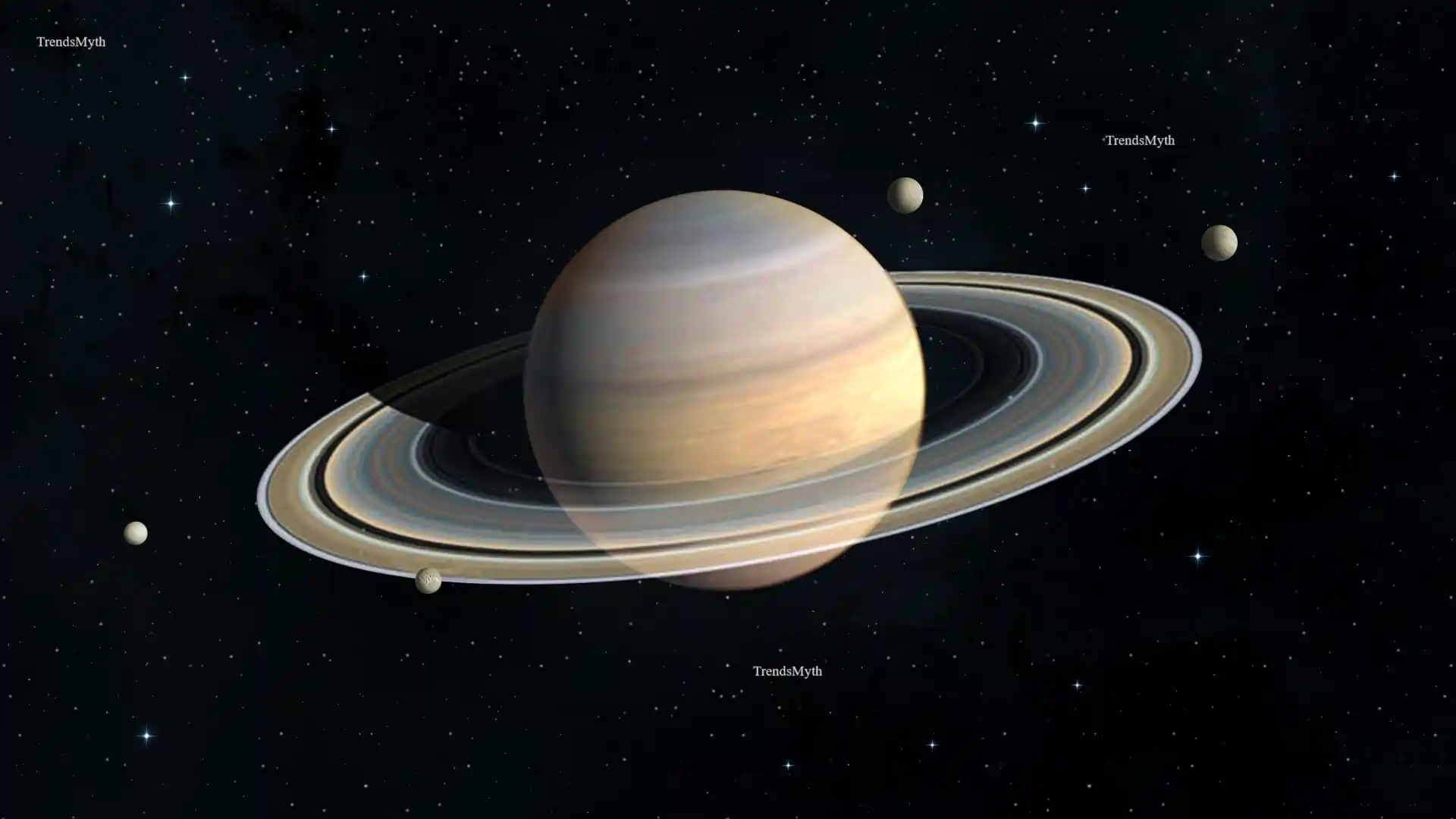Saturn is the sixth and largest planet in our solar system. Saturn has an incredible 145 moons. The Saturn planet is the farthest from Earth visible without a telescope, but its most striking features — the rings — can be seen better through one.
When Were Saturns Discovered?
Saturn was well known to ancient cultures around the globe, being visible with the naked eye, so people from ancient societies viewed it as a bright star that moved across the stars. Today, it’s known by many names and mythologies.
The International Astronomical Union (IAU), which represents astronomers worldwide, selected Saturn as the name for our solar system’s sixth planet. As noted by Encyclopedia Britannica, Saturn is associated with Roman deities associated with agriculture.
Saturn (Cronus in Greek mythology and Saturn/Cronus in Roman mythology) was an influential god from ancient Greek and Roman mythology, often called one of the Titans – gods who battled against the rising power of Jupiter or Zeus, respectively, in Roman and Greek mythologies – as part of the Titans grouping – he could even have different names and stories depending on your culture! Saturn can often be found among his ranks.
What is Saturn Made Of?
Saturn, an enormous gas giant planet made primarily of hydrogen and helium, is the second-most massive planet in our solar system at 95 times Earth’s mass.
Saturn is also less dense than water, so much so that if placed into an appropriate bathtub large enough, it would float – no mean feat for an orbiting object.
Saturn is famous for its vibrant yellow and gold bands created by superfast winds reaching over 1,100 miles per hour (1,800 km/h) and rising heat from within its interior.
Saturn rotates every 10.5 hours, and its fast rotation causes bulges at its equator while flattening out at the poles, approximately 75,000 miles wide at its equator and 68,000 miles from pole to pole, respectively.
Is Saturn The Only Planet With Rings?
Galileo Galilei was the first to observe Saturn’s rings through his powerful telescope. Then, his view showed them to resemble arms or handles instead.
Years later, Dutch astronomer Christiaan Huygens (1655) proposed that Saturn has thin, flat rings instead. Since then, we know many planets and smaller bodies like Jupiter, Uranus, and Neptune all possess these phenomena.
Scientists continued to learn more about Saturn’s rings as scientists developed more accurate instruments. Saturn is home to billions of tiny particles made up of rock and ice.
Some as small as grains of sugar or as large as houses – some from comets or asteroids, others possibly lunar fragments that broke off, while a 2016 study suggested they may even represent remnants of dwarf planets!
The largest of Saturn’s rings measures 7,000 times larger than Earth, while most main rings typically measure 30 feet (9 metres).
But recently, Cassini/Huygens discovered vertical formations within some circles: Particles had collected in bumps and ridges over 3 km (3 miles).
The rings of Saturn have been alphabetized in order of discovery. There are three main rings: C, B, and A – each is named accordingly – while their outermost ring could hold billions of Earths!
Separating rings A and B from each other lies the Cassini Division: an expanse that spans 2,920 miles (4700 km).
Saturn’s rings feature strange spokes that form and dissipate within hours, prompting scientists to hypothesise they may be caused by electrically charged sheets of dust particles generated by small meteors striking its rings or electron beams from the planet’s lighting sources.
Saturn’s F Ring also displays a braided look. Composed of multiple smaller rings, bends, kinks, and bright clumps can give them the impression of braiding; furthermore, asteroids and comets have altered their appearance to complicate things further.
Cassini, launched in 2004 and still operating today, made its closest approach to Saturn’s rings later than any other spacecraft.
While still processing data and making sense of everything it saw there, insight has already been gained about Saturn’s colours, unusual chemical compounds in “ring rain,” debris that falls from Saturn’s rings into its atmosphere, and measurements of its magnetic field.

Saturn’s Moons
Saturn Moon: Saturn boasts 145 satellites. Of those satellites, Titan is slightly bigger than Mercury and second only to Jupiter’s Ganymede, the second-largest moon (Earth’s Moon is the fifth-largest).
Pan and Atlas feature flying saucer-shaped moons, while Iapetus features bright and dark sides resembling coal and snow.
Enceladus provides an example of “ice volcanism,” wherein an ocean filled with chemical eruptions spews water through 101 geysers at its southern pole. This satellite is known as Shepherd Moon due to its interaction with its ring material.
Scientists have noted that Saturn’s small moons are constantly being formed and destroyed, even though scientists have identified many.
Titan
Titan, more significant than Mercury, features a hazy orange atmosphere similar to Earth before life arrived here approximately 3.5 billion years ago.
Titan’s atmospheric and precipitation are rich with complex organic molecules that make up one of the essential building blocks of life; studying Titan can teach us about the ingredients required to start life on our home planet or elsewhere in our galaxy.
Titan’s surface resembles Earth’s in many ways, yet differs significantly in several ways. Titan’s mountains and dunes are composed primarily of ice instead of rock; rivers, lakes, and seas on Titan are filled with liquid methane or ethane instead of water.
We believe there exists an underground liquid-water sea; however, we still don’t know whether or not its hydrothermal vents offer energy similar to what Earth oceans possess.
Titan, Saturn’s largest satellite, stands out as an exciting destination in search of life due to its liquid surface and thick atmosphere. As such, it makes an attractive target for exploration.
Enceladus
Enceladus is only 500 km wide (310 miles), which would fit inside Arizona, the U.S. State. This moon hides a secret beneath its icy surface: a vast saltwater ocean.
The water leaks out through geysers at the surface, forming one of Saturn’s outer rings. We know that the sea is full of complex organic materials.
Enceladus, Saturn’s largest moon, is characterised by its “tiger stripes” and subsurface ocean.
Mimas
Mimas has a huge crater, which is eerily similar in appearance to the Death Star of Star Wars. It may also have a subsurface sea, although material from the ocean doesn’t appear to leak to the surface.
The Oddballs
Saturn’s smaller satellites are some of the most gorgeous in our solar system. Dione and Rhea feature snowball-shaped bodies with rocky centres.
At the same time, Hyperion looks like a coral reef or giant sponge; Iapetus has two faces- one dark and one light- which receive material from Phoebe, an extinct comet-like satellite.
At the same time, Pan is heavily weighted down by gravity, and its mass makes it look like a flying saucer or a dumpling, depending on who you ask!
Saturn’s Aurora
Saturn has been home to some stunning aurora displays. Similar to those seen here on Earth and the moon, these ribbons of light form when solar winds pass over its surface and interact with its atmosphere.
Saturn’s auroras differ significantly from Earth’s in that they can only be seen using space telescopes – as Earth’s atmosphere blocks out that part of the electromagnetic spectrum.
NASA reports that Pioneer 11 first saw Saturn’s auroras in 1979 when it observed an ultraviolet brightening above Saturn’s poles.
Voyager 1 & 2 then provided basic observations when they flew past in the early 80s. Still, in 1994-1995, Hubble wasn’t Wide Field and Planetary Camera captured our first view of this spectacular light show.
Saturn Research And Missions
Pioneer 11 was the first spacecraft, launched in 1979, to approach Saturn within 13,700 miles and return images that allowed astronomers to discover two of Saturn’s outer rings and its strong magnetic force.
Voyager allowed researchers to learn that Saturn’s outer rings are composed of multiple smaller ringlets; its data also led them to three satellites of Saturn.
Cassini, Saturn’s orbiter spacecraft, was the largest interplanetary probe ever constructed. Measuring two stories tall and weighing six tons (5.4 metric tonnes), its two-story search weighed six tons – more than any previous interplanetary spacecraft!
Cassini assisted in identifying plumes on Enceladus while carrying Huygens Probe through Titan’s atmosphere before successfully landing on its surface after its successful plunge through Titan’s atmosphere.
Cassini completed its 10-year observation mission of Saturn and its moons with remarkable data and imagery of their surfaces and satellites, recreating an image known as “Pale Blue Dot,” which first captured Earth behind Saturn back in 2013.
Cassini’s mission ended in September 2017 due to low fuel levels, allowing its intentional crash into Saturn to avoid contamination or damage to any moon.
Scientists have proposed missions exploring Enceladus, Titan, and their icy moon. NASA announced in 2019 their plan to launch Dragonfly by 2026 with arrival at Titan by 2034; onboard instruments include a mass spectrometer to search for signs of life on Titan.
Saturn’s Influence Over The Solar System
Saturn is the second-most massive planet in our solar system after Jupiter, and its gravitational pull has enormously influenced its development.
Saturn could have violently pulled Neptune and Uranus closer together or created debris flow across Jupiter into inner planets early in system history.
Researchers continue to learn more about the formation of gas giants like Jupiter and Saturn through computer models, with one 2017 study concluding that Saturn was more successful at deflecting dangerous asteroids away from Earth than Jupiter was.
Saturn Questions Answered
Leah Sacks, a Ph.D. candidate at Western University (Ontario, Canada), works on planetary tectonics and ice moons. Her research is focused on the formation of chiasmata and tensile stress on the ice surfaces of small moons.
Does Saturn Lose Its Rings?
Saturn’s rings are ever disappearing but at a languid pace. The rings aren’t fading as fast as we could see with a telescope, but they slowly fall into Saturn.
What Are The Components Of Saturn?
Saturn’s layers are almost all made up of different forms of hydrogen. Saturn’s core is thought to be primarily made up of liquid and solid metallic hydrogen.
Hydrogen, helium, water, and small amounts of ammonia and other gases, such as hydrogen, make up Saturn’s atmosphere and clouds. The rings are almost entirely made of water ice.
Can Human Beings Live On Saturn?
Saturn is a gas-giant planet, and humans cannot live there because they have no solid ground to stand on. Saturn’s solid-surfaced moons may be able to support humans, but they lack breathable air.
Shortly, there’s a better chance of humans exploring the Earth’s Moon and Mars until better technology is developed to help analyse the Saturn system.
How Do Saturn’s Rings Look Up Close?
Saturn’s rings consist of chunks made chiefly from water ice, ranging from the size of dust specks to that of a mountain.
The most significant pieces of water ice, called moonlets, are large enough to have enough gravitational force to cause waves and distort the shape of Saturn’s rings.
Where Do Saturn’s Rings Originate?
Scientists theorise that Saturn’s rings may have formed when an enormous moon was torn apart by intense gravitational force or when Saturn came into being.
Saturn’s rings will gradually fade over 300 million years; their size compared to those found on Jupiter, Uranus, and Neptune is somewhat less impressive.
Saturn stands out among our three outer planets as an intricate solar system with many intriguing targets to study.
RELATED ARTICLE: EXPLORING MARS WHERE LIFE CAN BE POSSIBLE IN FUTURE











1 thought on “Saturn: Know About Saturn Planet, Their Rings & Moon”